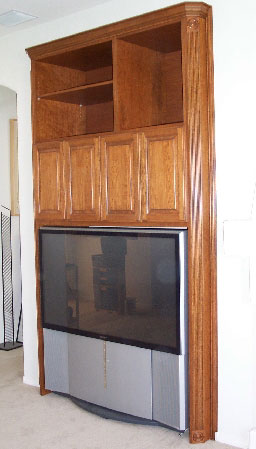Door Stops for Cabinets
Ways to hold inset cabinet doors flush to the face, when closed. March 20, 2006
Question
Installing flush inset doors using cup hinges on a frameless cabinet causes the door to close inside the face plane of the case (opposite the hinges). Anyone have ideas or source for an adjustable stop?
Forum Responses
(Cabinetmaking Forum)
From contributor F:
I think the best thing going for that problem right now is the soft close Blumotion stop. They are not very adjustable, however. A slight learning curve on the various holders for the stoppers. Customers think they are very nice and high tech.
From contributor D:
A small block screwed on behind the door does the trick. Drill some slots for adjustability. Set it back enough to allow for cushion/bumpers. The middle of the door is ideal, but top of the door will work. On larger doors, go top and bottom if middle isn't available. The self-close hinge will put enough pressure on the door in closed position to sometimes warp the door in a little where there isn't a stop. That's why the middle is ideal. Of course, without partitions or fixed shelves, you're out of luck. With frame cabs you can usually stick a block behind the frame. Free swing hinges with catches are another route to go.
From contributor L:
I second the block, but when you install your shelves, the door(s) shouldn't do that anymore.
From contributor A:
Magnet.
From contributor D:
...that's if there are shelves, and if they're the right size (depth) to stop the door.
From contributor K:
There are various methods, some already mentioned. Some are more efficient to install, and some just look better...
Easier to install:
1. Magnetic catch with strike plate (a few screws)
2. Double roller latches (a few screws)
3. Twin ball adjustable catches (a few screws)
4. Magnetic inset lip catch (a few screws)
With the magnetic catches, you'll want to pay attention to the pull force required (9-12lbs. of force is usually most comfortable).
Less efficient to install, but look better:
1. Bullet catches
2. Adjustable drive-in magnetic catch
3. Magnetic touch/push latch, single or double barrel
4. Blumotion with inset adapter plate
What we use, and is both efficient and good looking, is a 2" finished rail (same as FF) behind the face frame, set 3/4" down into the opening of the frame. Granted, it's old school, but it's easy to install, no adjustments and the step-down provides a beefy look.
From contributor G:
I edgeband the front edge of the bottoms of my cabinetry and make the cabinets 3/8" shorter than normal to allow the bottom of the cabinet to show that 3/8" inside the cabinet frame. It allows a little fudge room when attaching the frame and it's also a great stop for the door without adding blocks or catches. The step that it shows when the doors are open is a classy look. On wall cabinets, it also allows for an extra 3/8" for finished bottoms and puck lights.
From the original questioner:
There were no shelves to act as stops and there was no face frame to raise the case bottom against. I ended up making my own stops out of walnut to match the casework. These were fitted with threaded inserts and a machine screw with a plastic cap and felt bumper. Very low profile, good looking and quite inexpensive. Adjusts beautifully and only one screw was needed to hold it in place. Thank you!
